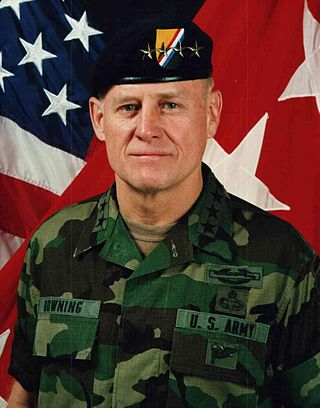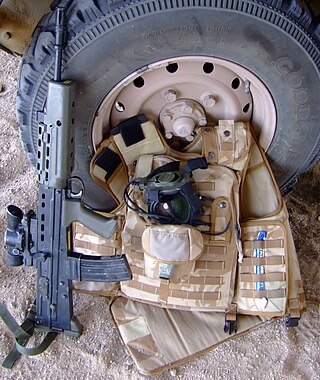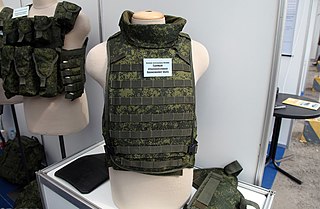
A bulletproof vest, also known as a ballistic vest or a bullet-resistant vest, is an item of body armour that helps absorb the impact and reduce or stop penetration to the torso by firearm-fired projectiles and fragmentation from explosions. The vest may come in a soft form, as worn by many police officers, prison officers, security guards, and some private citizens, used to protect against stabbing attacks or light projectiles, or hard form, using metallic or para-aramid components. Soldiers and police tactical units wear hard armour, either in conjunction with soft armour or alone, to protect against rifle ammunition or fragmentation.

The 75th Ranger Regiment, also known as Army Rangers, is the premier light infantry unit and special operations force within the United States Army Special Operations Command. The regiment is headquartered at Fort Moore, Georgia and is composed of a regimental headquarters company, a military intelligence battalion, a special troops battalion, and three Ranger battalions.
The Interceptor Multi-Threat Body Armor System (IBA) is a bullet-resistant body armor system that was used by the United States Armed Forces during the 2000s, with some limited usage into the mid-2010s. IBA and its design replaced the older standardized fragmentation protective Personnel Armor System for Ground Troops (PASGT) body armor system that was designed in the late 1970s and introduced in the early 1980s.

Personnel Armor System for Ground Troops is a combat helmet and ballistic vest that was used by the United States military from the early 1980s until the mid-2000s, when the helmet and vest were succeeded by the Lightweight Helmet (LWH), Modular Integrated Communications Helmet (MICH), and Interceptor Body Armor (IBA) respectively.

A flak jacket or flak vest is a form of body armor. A flak jacket is designed to provide protection from case fragments ("frag") from high explosive weaponry, such as anti-aircraft artillery, grenade fragments, some types of pellets used in shotguns, and other lower-velocity projectiles. It is not designed to protect against bullets fired from most small arms such as rifles or handguns. However flak jackets are able to sustain certain gunshots, depending on the angle at which the shot was fired, the caliber of the bullet, the speed of the projectile and the range from which the shot was fired.

Body armor, personal armor, armored suit (armoured) or coat of armor, among others, is protective clothing designed to absorb or deflect physical attacks. Historically used to protect military personnel, today it is also used by various types of police, private security guards, or bodyguards, and occasionally ordinary citizens. Today there are two main types: regular non-plated body armor for moderate to substantial protection, and hard-plate reinforced body armor for maximum protection, such as used by combatants.

The Small Arms Protective Insert (SAPI) is a ceramic ballistic plate used by the United States Armed Forces. It was first used in the Ranger Body Armor and Interceptor Body Armor, both are ballistic vests. It is now also used in the Improved Outer Tactical Vest as well as the Modular Tactical Vest, in addition to commercially available "plate carriers". The Kevlar Interceptor vest itself is designed to stop projectiles up to and including 9×19mm Parabellum submachine gun rounds, in addition to fragmentation. To protect against higher-velocity rifle rounds, SAPI plates are needed.

The Modular Integrated Communications Helmet (MICH) is a U.S. combat helmet and one of several used by the U.S. military. It was developed by the United States Army Soldier Systems Center to be the next generation of protective combat helmets for use by the U.S. Army.

The Advanced Combat Helmet (ACH) is the United States Army's current combat helmet, used since the early 2000s. It was developed by the United States Army Soldier Systems Center, the U.S. Army Special Operations Command, and the U.S. Army Research Laboratory to be the next generation of protective combat helmets for use by the American ground forces. The ACH is derived from the Modular Integrated Communications Helmet.
The United States Army Regimental System (USARS) is an organizational and classification system used by the United States Army. It was established in 1981 to replace the Combat Arms Regimental System (CARS) to provide each soldier with continuous identification with a single regiment, and to increase a soldier's probability of serving recurring assignments with his or her regiment. The USARS was intended to enhance combat effectiveness by providing the opportunity for a regimental affiliation, thus obtaining some of the benefits of the traditional regimental system.

Wayne Allan Downing was a four-star United States Army general born in Peoria, Illinois. He graduated from the United States Military Academy with a Bachelor of Science degree in 1962 and held a Master of Business Administration degree from Tulane University. He also served on the board of directors at a US Government focused high-tech company, Science Applications International Corporation (SAIC).

Osprey body armour is a system of body armour used by the British Armed Forces. The system is in its fourth iteration following extensive development and engagement with front line users.

The Improved Outer Tactical Vest (IOTV) is an enhanced version of, and a replacement for, the older Outer Tactical Vest (OTV) component of the Interceptor Multi-Threat Body Armor System, as fielded by the United States Army beginning in the mid-2000s. The IOTV is compatible with the Deltoid and Axillary Protector System (DAPS) components, ESAPI, Enhanced Side Ballistic Inserts (ESBI), as well as the OTV's groin protector. It has a flame-resistant standalone shirt, the Army Combat Shirt (ACS), designed specifically for use with the IOTV.

In the United States (US) military, a beret flash is a shield-shaped embroidered cloth that is typically 2.25 in (5.72 cm) tall and 1.875 in (4.76 cm) wide with a semi–circular base that is attached to a stiffener backing of a military beret. These flashes—a British English word for a colorful cloth patch attached to military headgear—are worn over the left eye with the excess cloth of the beret shaped, folded, and pulled over the right ear giving it a distinctive appearance.
In 2009, the United States and NATO International Security Assistance Force (ISAF) coalition, along with Afghan National Army forces, continued military operations against the Taliban in Afghanistan. 2009 marks the eighth year of the War in Afghanistan, which began late in 2001. And 75th ranger regiment is also in Afghanistan as of 2018

The use of personal protective equipment (PPE) is inherent in the theory of universal precaution, which requires specialized clothing or equipment for the protection of individuals from hazard. The term is defined by the Occupational Safety and Health Administration (OSHA), which is responsible for PPE regulation, as the "equipment that protects employees from serious injury or illness resulting from contact with chemical, radiological, physical, electrical, mechanical, or other hazards." While there are common forms of PPEs such as gloves, eye shields, and respirators, the standard set in the OSHA definition indicates a wide coverage. This means that PPE involves a sizable range of equipment. There are several ways to classify them such as how gears could be physiological or environmental. The following list, however, sorts personal protective equipment according to function and body area.
The Modular Body Armor Vest (MBAV) is a bullet-proof vest made by Eagle Industries and used by the United States military. The vest is standard issue for many members of the United States special operations forces including the 75th Ranger Regiment. 10,000 vests were deployed on an interim basis with the U.S. Marine Corps while it developed the Scalable Plate Carrier. The vest was also evaluated by the U.S. Army.

The 173rd Airborne Brigade is an airborne infantry brigade combat team (IBCT) of the United States Army based in Vicenza, Italy. It is the United States European Command's conventional airborne strategic response force for Europe.

The Infantry Branch is a branch of the United States Army first established in 1775.

6B45 is a standard ballistic vest of the Armed Forces of the Russian Federation. It is a part of Ratnik infantry combat system. It was adopted in 2014 as a replacement for the 6B23 vest. 6B45 vest has been developed by Techinkom company located in Saint Petersburg.

















